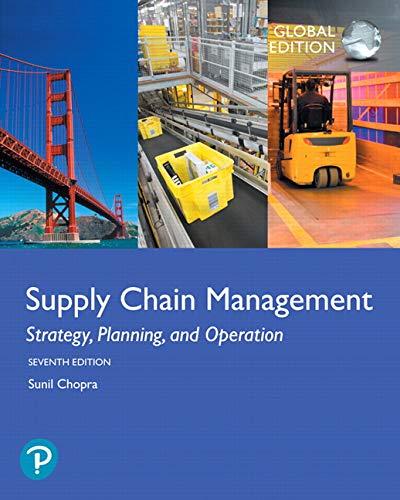Penang Electronics (PE) is a contract manufacturer that produces and packages private-label products for several retail chains,
Question:
Currently, a production facility in Malaysia is used to manufacture, label, and pack all products. The manufacturing facility replenishes a DC in St. Louis, from which the contract manufacturer fills all customer orders. The manufacturing and transportation lead time from Penang to St. Louis is nine weeks. PE uses a continuous review policy to manage inventories at its DC and aims to provide a cycle service level of 95 percent for each product to every customer.
The previous month had been very challenging because Best Buy requested 5,000 additional units beyond what was available at the DC, whereas Target ordered 3,500 fewer units and Staples ordered 4,000 fewer units. Even though there was sufficient product inventory available at the DC (in the form of the basic product), PE could not meet the Best Buy request because the excess inventory available was labeled and packed for other customers. The DC had leftover inventory from Target and Staples, which unfortunately could not be used to serve Best Buy. PE had lost business while carrying surplus inventory, all because of the wrong labels and packaging.
Labeling and Packaging at the DC
The vice president of supply chain at PE proposed postponing the final labeling and packaging to the DC. Her logic was that postponing labeling and packaging to the DC would allow PE to use all available inventories to serve any customer. In particular, the situation that arose in the previous month when Best Buy did not get its entire order could have been avoided through postponement. If packaging was shifted to the DC, the lead time of manufacturing and transporting the basic product from Malaysia would continue to be about nine weeks. Labeling and packaging were relatively quick steps and the response time from the DC to the customer was not expected to change.
The DC management was opposed to this idea because it would create additional work that was different from what they had done so far. A detailed study of the production process showed that labeling and packaging at the DC cost $2 per unit more than the cost of labeling and packaging in Malaysia. DC management believed that this increase in cost would be held against them once the process was changed, and they would be under constant pressure to lower cost. They also believed it would complicate the work they did when filling an order and could adversely impact customer service.
Evaluating the Two Options
To evaluate the two options, a team from both manufacturing and the DC was set up. The team decided to focus its analysis on three major product categories—computers, printers, and scanners, and four major customers—Target, Best Buy, Staples, and Office Max. Weekly demand for each product and customer is shown in Table 12-9. In each case, “Mean” indicates the average weekly demand, and “SD”

indicates the standard deviation of weekly demand. All demand was assumed to be normally distributed. PE incurred a total cost of $1,000 per computer, $300 per printer, and $100 per scanner. Given the short life cycle of these products, PE used an annual holding cost of 30 percent when making its inventory decisions. It was assumed that batch sizes and cycle inventories would be unchanged irrespective of where packaging and labeling were done. Thus, the team analyzed the impact of postponement on safety inventories before making a final recommendation.
Questions
1. What is the annual holding cost of safety inventory for the current system in which product is produced, labeled, and packed in Malaysia before being shipped to the DC?
2. How would the holding cost of safety inventory change if labeling and packaging were moved to the DC? Evaluate the change in inventory costs as the correlation coefficient of demand between any pair of customers varies from 0 to 0.5 to 1.0.
3. How should PE set up its production, labeling, and packaging processes? Does your answer change if the additional cost of labeling and packaging at the DC is reduced to $1 (from the current value of $2)?
Step by Step Answer:

Supply Chain Management Strategy Planning And Operation
ISBN: 9781292257891
7th Global Edition
Authors: Sunil Chopra





